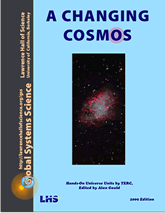AC1. Cosmic Cataclysms
I. Mass Extinction
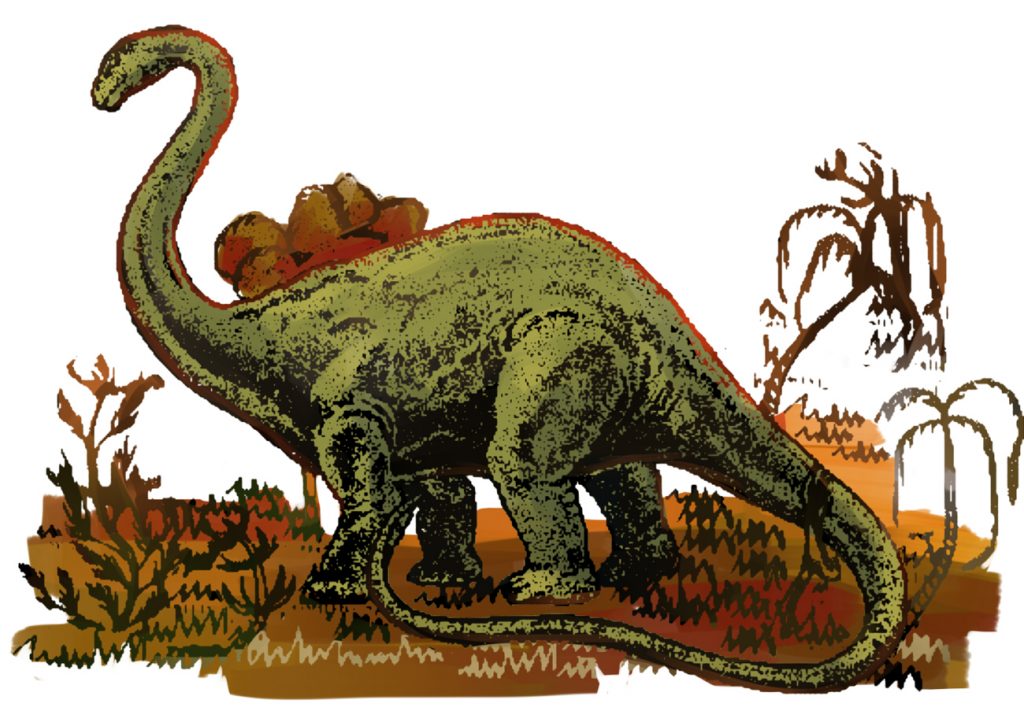
We normally think of things in space as remote—not really affecting things around us. But there are some types of cosmic events that could really mess things up badly for us. In fossil records, there are many instances of species going extinct—apparently unable to cope with some change in environment. Sometimes in Earth’s history, not just one species but lots of species has died off in mass extinctions.
The latest mass extinction happened 65 million years ago, when the Age of Reptiles ended and the Age of Mammals began. The question, “What caused the mass extinction at the end of the dinosaur age?” made scientists disagree and squabble for quite a while.
The candidate theories for the cause were:
a. The theory of gradual change — mass extinctions took place over thousands or maybe millions of years, possibly due to long term climate change. Fossil evidence indicates that prior to sixty-five million years ago the dinosaurs were beginning to decline and many dinosaur species had already become extinct.
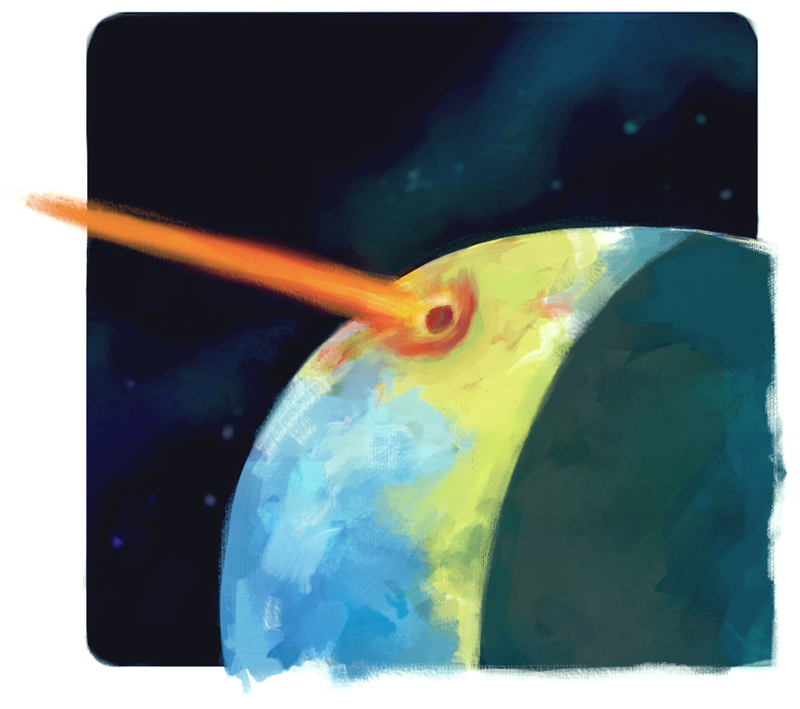
b. The impact theory — set forth by Geologist Walter Alvarez from the University of California at Berkeley. In Gubbio, Italy, he was studying a thin layer of clay between rock layers of the Cretaceous Period (Age of Reptiles) and the Tertiary Period (containing no dinosaurs fossils). The clay layer contained very large amounts of the rare element iridium, which is more common in meteorites than in the Earth’s crust. This suggested a sudden large influx of iridium—perhaps one really huge meteor struck the Earth at about that time. An underground crater found near Chixulub (pronounced Chi’-shoo-loob), Mexico, was found to be about 65 million years old. Additional evidence was found in the clay layer: it contained tiny pieces of minerals (shocked quartz) and glassy rocks (tektites), both of which are found at nuclear test sites and large meteor impact sites. There was also soot indicative of continent-sized forest fires. An asteroid in the 10 kilometer diameter size range could have caused the event.
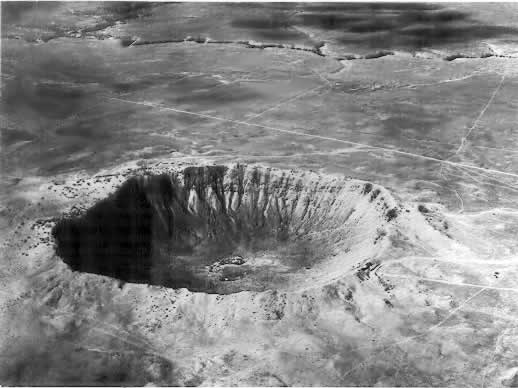
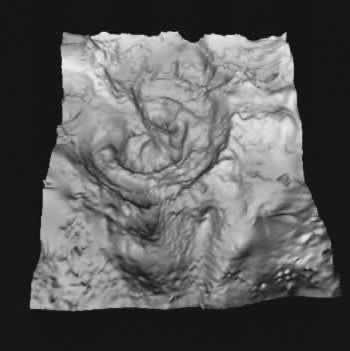
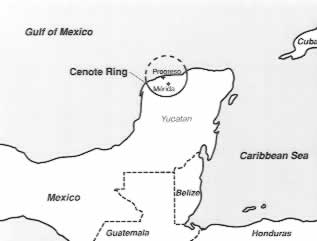
c. The volcanic eruption theory—A huge series of lava flows in India, named the Deccan Traps, which covers 10,000 square kilometers and is in some places more than 2 kilometers thick, is evidence of a period of volcanic activity that spanned about half a million years—including the period of the mass extinction at the end of the Cretaceous Period. The volcanic eruption theory is in agreement with paleontologists’ original idea that the extinction of species was gradual, or at least occurred in several steps, over hundreds of thousands of years.
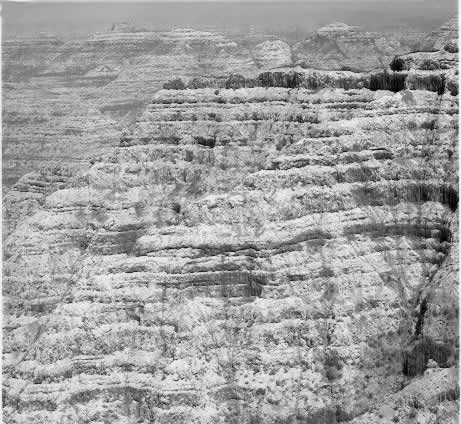
Source: © Dr. Keith G. Cox, University of Oxford, Oxford, England.
II. Which Theory is Right?
It may well be that we will never know for sure if either a large impact or massive volcanism caused the death of the dinosaurs.
Will Earth be Hit by a Large Asteroid?
Eventually, it is likely. But the odds of one hitting tomorrow, or next week, or in the next few thousand years are quite low. Of course tons of smaller bodies (sand grain size) enter Earth’s atmosphere every day. But the larger the body, the rarer it is.
Asteroids are not the only menace. Evidence of comets crashing into planets was dramatically seen in 1994 when the large comet Shoemaker-Levy 9 fragmented and created huge explosions when it struck the planet Jupiter at more than 20 different sites. We’ll find out more about this event at the end of Chapter 3.
It would behoove us to seek advance warning of such an approaching body. An asteroid could come in quickly, but it may be technically possible to deflect an asteroid from an Earth impact course if there is enough advance warning.
The Search for Near Earth Asteroids (NEOs)

Asteroids must be discovered and their orbits tracked. At this point in time North American Aerospace Defense Command (NORAD) has a limited number of people monitoring the skies for asteroids. There is also a project called Space Guard which is an international network of telescopes and people working together to discover and track asteroids, with the idea of providing lots of advance warning if an asteroid is found to be on a collision course with Earth, so that an effort could be made to divert it. In the 1990s NASA carried out the Spaceguard Survey to find NEOs greater than 140 meters in diameter. This program was budgeted at $4.1 million per year for FY 2006 through FY 2012. Most recent findings can be found at the NASA Near Earth Object Program website (http://neo.jpl.nasa.gov)

AC1.1. Down2Earth Crater Impact Calculator
Try out this interactive simulation for Crater Impacts.
http://simulator.down2earth.eu/
Use it to answer questions such as:
- What is the relationship between the size of impactor and the crater size?
- What effect does the angle of impact have?
- How does the speed of the impactor affect the crater size?

2021 – DART
The NASA Double Asteroid Redirection Test (DART; https://dart.jhuapl.edu) mission is a test of the feasibility of asteroid deflection as a way to avert asteroid collision with Earth. It is NASA’s demonstration of kinetic impactor technology, impacting an asteroid to adjust its speed and path, to perform a test before any actual need is present.
Launch Window:
November 24, 2021 – February 15, 2022
DART Impact: September – October 2022
In chapter 7, we’ll learn more about asteroids, as well as other bodies in the solar system.
III. Supernova
It is in the darkness before dawn on July 4, 1054 A.D. Chinese astronomers are greatly excited by the appearance of a “guest star”—a new star in the sky, never seen before. As the Earth spins, half a day later on July 5, it is predawn in Navajo lands of what is now northern Arizona. The Anasazi, the “ancient ones” of this region, have spotted that same new star and are equally excited. The legacy of that “guest star” continues to this day.
Each culture records the event in its own way. Anasazi etch a rock drawing—a petroglyph—on a rock overhang, depicting a circle next to a crescent Moon as it appeared to them that morning. Petroglyphs in Navaho Canyon and White Mesa, Arizona, as well as in the Chaco Canyon National Park of New Mexico are lasting records left by those Anasazi skywatchers. Mimbres Indian ceramic art from New Mexico also apparently depicted the supernova.
Japanese and Chinese astronomers record that the “guest star” shone at least as bright as the maximum brightness of planet Venus. Some said it was about four times brighter than Venus, which was nearly a hundred times brighter than the brightest stars in the sky (aside from the Sun). It was visible in broad daylight for 23 days, and in the night sky it shone for 653 days to the naked eye. Its location was in a part of the sky that we now call the constellation Taurus.
Six hundred and seventy seven years later, in 1731, a nebulous cloud was spotted in the constellation Taurus by John Bevis through his telescope. Charles Messier observed the nebula again through a telescope on August 28, 1758, and first thought it was a comet. He recorded it in a catalog he was compiling to help him distinguish comets which he eagerly sought to discover from “comet impostors” which stayed always in the same places in the sky. In 1844, the 3rd Earl of Rosse, at Birr Castle in Ireland, examined and made a detailed drawing of the nebula using his giant 6 foot diameter, 56 foot long telescope. The drawing of the nebula resembled a “Crab” which has been the name of the nebula ever since.
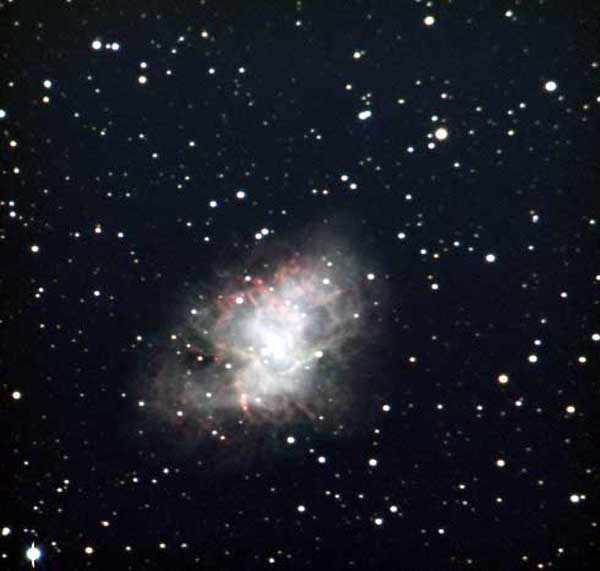
The Crab Nebula, or M1 in Charles Messier’s catalog of “comet impostors,” is in the exact same spot as the recorded position of the “guest star” of 1054. But it wasn’t until 1928 that Edwin Hubble measured the rate of expansion of the Crab nebula which led him to conclude that it had been expanding for about 900 years. The connection with the “guest star” of 1054 was clear. The “guest star” was actually a supernova—exploding star— and the Crab nebula, the supernova remnant, consists of the material ejected in the supernova explosion which has been spread over a volume approximately 10 light years in diameter and is still expanding at the very high velocity of about 1,800 km/sec.
A supernova is an unimaginably powerful explosive event. It occurs when a very large star, over eight times the Sun’s mass, has burned most of its nuclear fuel. When such a star’s central fires go out, its core collapses releasing a huge amount of gravitational energy. A blast wave ejects the star’s outer layers into space. The Crab nebula supernova remnant is incredibly bright, even though it looks quite dim at our distance from it—6,300 light-years. If we were to observe it from much closer, we would find that it puts out 1000 times as much visible light as our Sun. In 1948, the Crab nebula was found to be an even stronger source of radio wave radiation, and in 1964, observations with a high-altitude rocket showed that the energy emitted in X-rays by the Crab nebula is about 100 times more than that emitted in visual light. Taking into account all energies of radiation, the Crab nebula is putting out over 100,000 times more energy than our Sun.
Another indication of the violence of a supernova explosion is that in some cases all that is left is a neutron star, which is an extremely dense object. It is denser than an atomic nucleus, concentrating more than the entire mass of the Sun in a volume only 30 kilometers (20 miles) across. On November 9, 1968, a pulsating radio source was discovered in the Crab nebula by astronomers using a 300-meter radio telescope in Arecibo, Puerto Rico. It pulses about 30 times per second! It’s that neutron star (pulsar) rotating 30 times per second and putting out 100,000 times more energy than our Sun.
If the Crab nebula pulsar is pumping out that much energy now, over 900 years after the supernova explosion, how much energy did the supernova release at its peak? At its brightest, a supernova can put out the energy of 10 billion suns!
Could Our Sun Become a Supernova?
Not a chance! Our Sun is not large enough to become a supernova of any sort. Besides, it will take another 5 billion years before our Sun’s supply of hydrogen is depleted. At that time it will begin its dying process and eventually become a white dwarf with a surrounding shell of material much like the Ring Nebula (M57) in the constellation of Lyra!
Can a Nearby Supernova Affect Us on Earth?
Yes, if it’s near enough, within several dozen light-years. The intense influx of radiation could kill all life on Earth, sterilizing the planet. However, the odds of this happening are extremely small, especially in the short life-span of us humans. The most important effects of more distant supernovae are extreme excitement among astronomers who study supernovae to understand cosmology—the history and fate of the Universe.
We will be learning a great deal more about supernova in Chapter 5.
IV. The Sun Engulfs the Earth

If you have read the book or seen the movie “The Time Machine” by H.G. Wells, you may know of the eerie landscape that the Time Traveller (Alexander Hartdegen) saw near the end of his time travels. The passage here is from Chapter 11 of H.G. Wells’s The Time Machine as serialized in the New Review, cut from the book, but later published as a short story, “The Grey Man.”
“I have already told you of the sickness and confusion that comes with time travelling. …when I brought myself to look at the dials again I was amazed to find where I had arrived. One dial records days, another thousands of days, another millions of days, and another thousands of millions. …the thousands hand was sweeping round as fast as the seconds hand of a watch—into futurity.
“…I stopped. …The time was midday, the orange sun, shorn of its effulgence, brooding near the meridian in a sky of drabby grey.
“…I rose to my feet, and stared at this grotesque monster. I can only describe it by comparing it to a centipede. It stood about three feet high, and had a long segmented body, perhaps thirty feet long, with curiously overlapping greenish-black plates. It seemed to crawl upon a multitude of feet, looping its body as it advanced. Its blunt round head with a polygonal arrangement of black eye spots, carried two flexible, writhing, horn-like antennae. It was coming along, I should judge, at a pace of about eight or ten miles an hour, and it left me little time for thinking.
“…When I gained the machine the monster was scarce fifty yards away. It was certainly not a vertebrated animal.
“…But I did not care for a nearer view.
“…As I drove on, a peculiar change crept over the appearance of things. The unwonted greyness grew lighter; then—though I was travelling with prodigious velocity—the blinking succession of day and night, which was usually indicative of a slower pace, returned, and grew more and more marked. This puzzled me very much at first. The alternations of night and day grew slower and slower, and so did the passage of the sun across the sky, until they seemed to stretch through centuries.
“At last a steady twilight brooded over the earth, a twilight only broken now and then when a comet glared across the darkling sky. The band of light that had indicated the sun had long since disappeared; for the sun had ceased to set—it simply rose and fell in the west, and grew ever broader and more red. All trace of the moon had vanished. The circling of the stars, growing slower and slower, had given place to creeping points of light.
“At last, some time before I stopped, the sun, red and very large, halted motionless upon the horizon, a vast dome glowing with a dull heat, and now and then suffering a momentary extinction. At one time it had for a little while glowed more brilliantly again, but it speedily reverted to its sullen red-heat. I perceived by this slowing down of its rising and setting that the work of the tidal drag was done. The earth had come to rest with one face to the sun, even as in our own time the moon faces the earth.”
Wells described how our Sun might appear not after thousands of years, or even millions of years, but after a few billion years. Current theories for progression of the Sun in its lifetime predict that when the nuclear furnace at its core runs out of fuel, it will begin a stage of expansion and surface cooling that will make it huge and its surface red—a red giant star. The surface could swell up big enough to engulf the current orbit of Earth. Even if the gravitational pull of the Sun will have weakened by then from loss of mass, so that Earth migrates to a larger orbit, Earth still will get hot enough for the oceans to evaporate to space, and our biosphere will be destroyed.
The good news is the enormous time span before this particular fate occurs. Humans may not even be recognizable as humans by then, in terms of species adaptations.
V. Understanding, Helplessness, and Empowerment
Understanding three ways that life on Earth could be threatened by cosmic events can invoke various reactions.
- In the case of the threat of the Sun in its red giant stage, we are pretty much helpless for now, but not too many people are worrying a whole lot about what will be happening in 5 billion years.
- In the case of a nearby supernova explosion, we are also pretty much helpless, since protecting the Earth from a huge influx of planet-wide radiation is a bit much to contemplate in practical terms. However, we can learn about what the probabilities are for such a scenario, and for the time being, the likelihood of that kind of disaster is exceedingly low, almost vanishingly so.
- The likelihood of Earth being hit by a large body, such as an asteroid, is much, much higher than our being saturated by radiation from a supernova. It is nearly inevitable—only a matter of time, though we do not know if it will be today, tomorrow, or in many millions of years. But in this scenario, we certainly are not helpless. If we are able to detect a body that is hurtling towards Earth with enough advance warning, there are a number of strategies proposed to avert disaster. It’s tempting to try blowing the thing up with nuclear weapons, a typical video game-style mentality, that unfortunately, at best, would create a number of smaller bodies that would still continue on their trajectories and impact Earth with devastating effect. Other ideas are mostly different ways of nudging the asteroid to deflect it into a path that will not strike Earth.
This book is devoted to better understanding various astronomical ideas, many of which relate directly or indirectly with the challenge of early detection of “near Earth asteroids,” as well as other intriguing aspects of our “changing cosmos.”
See Staying current for this chapter.


